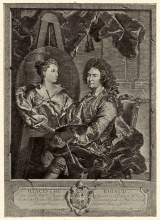The Dressing of the Hair, Moustachios and Beard (7)
Previous pageWigs when first worn were extremely expensive, costing as much as a hundred guineas, and their value often led to their being stolen from the head.
 The different shapes which the wig assumed were innumerable, and the different classes of
society were identified with particular shaped wigs. There were the clerical and the physical; the huge tie peruke for the man of law,
the brigadier and the tremendous fox-ear or cluster of temple curls with a pigtail behind, for the Army and Navy.
(The Army pigtail was shortened to seven inches in 1804, and in 1808 was cut off altogether.) The merchant, the man of business and of
law affected the grave full-bottom; the tradesman was distinguished by the snug bob or natty scratch; the country gent by the natural
fly and hunting peruke; "the coachman wore his, as do some to this day, in imitation of the curled hair of a water-dog."
The different shapes which the wig assumed were innumerable, and the different classes of
society were identified with particular shaped wigs. There were the clerical and the physical; the huge tie peruke for the man of law,
the brigadier and the tremendous fox-ear or cluster of temple curls with a pigtail behind, for the Army and Navy.
(The Army pigtail was shortened to seven inches in 1804, and in 1808 was cut off altogether.) The merchant, the man of business and of
law affected the grave full-bottom; the tradesman was distinguished by the snug bob or natty scratch; the country gent by the natural
fly and hunting peruke; "the coachman wore his, as do some to this day, in imitation of the curled hair of a water-dog."There were also, as a writer in the London Magazine of 1753 informs us, the pigeon's wing, the cornet, the cauliflower, the royal bird, the staircase, the ladder, the brush, the wild boar's back, the temple, the rhinoceros, the corded wolf's paw, Count Saxe's mode, the she-dragon, the rose, the crutch, the negligent, the chancellor, the cut bob, the long bob, the half natural, the chain-buckle, the corded buck le, the snail back, and many others.
The coif-cap is still worn on occasions when the Judge passes sentence of death, but with the colour changed to black, the cap being worn over the wig.
Samuel Rogers in his "Table Talk" tells a good story of Lord Ellenborough's wig. On one occasion when the distinguished Judge was about to go on circuit, his Lady intimated that she would like to accompany him. He replied that he had no objection, provided she did not encumber the carriage with band-boxes, which were his utter abhorrence. During the first day's journey, happening to stretch his legs, he struck his foot against something below the Beat, and discovered that it was one of the detested band-boxes. Up went the window, and out went the band-box. The coachman stopped, and the footman, thinking that the band-box had tumbled out of the window by some extraordinary chance, was about to pick it up. "Drive on !" thundered his lordship. The band-box was accordingly left by the ditch. Upon his arrival at the court at which he was to officiate, and arraying himself for his appearance at the court-house, "Now," said he, "where's my wig? where is my wig?" My lord,"replied the attendant," it was thrown out of the carriage window!"
From 1770 onwards was the period of the highest blossoming of feminine head-gear. The bodies of these enormous creations were formed of tow, over which the hair was drawn in great curls, rolls, bobs, &c., with false hair added, the whole freely plastered over with powder, pomatum, &c., decorated with huge bows, ribbons, feathers, and flowers.
In the "Macaroni Dialogue " — a colloquy between Sir Harry Dimple and Lady Betty Frisky — in the Lady's Magazine, iv. 1773, which is illustrated by a picture of a lady and gentleman discussing with great animation the merits of the male and female costumes of this period, in which they are clad, the gentleman is presenting to the lady a nosegay, and she invites his interest in the excessively lofty coiffure which she is wearing.
"Permit me to present your ladyship with this boquet — it has been to Warren's, doubly perfumed and scented; so that positively, my lady, it has not the least of the vulgar odour of the flowers." "I vow, Sir Harry, you are a man of such nice sensations that you would do honour to nobility. I am surprised you have hitherto been overlooked in the creation of Lords." "To be sure, my lady, my taste has never yet been called into question. It was I who first dethroned those abominable monsters the Bucks, and established the reign of the Macaronies — who first improved upon the Poudre á la maréchale by throwing in a dash of the violet.
Next Page 01 02 03 04 05 06 07 08 09 10 11 12